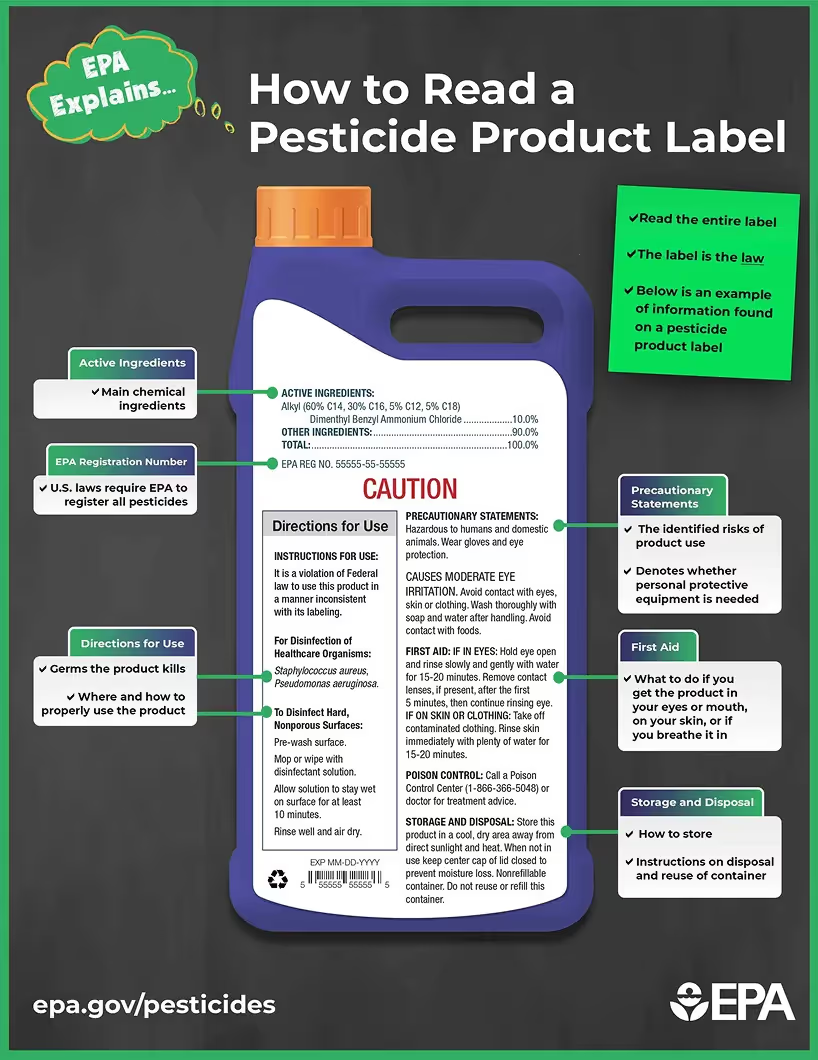This blog outlines the EPA pesticide labeling requirements, offering clear directives
What Is the EPA Label Review Manual?
The EPA Label Review Manual (LRM) is a document published by the United States Environmental Protection Agency to provide guidance on evaluating pesticide labels for compliance with federal law.
This specifically includes the Federal Insecticide, Fungicide, and Rodenticide Act (FIFRA). The manual is primarily used by EPA staff and state agencies, but it's also widely used by registrants to ensure label submissions meet regulatory standards.
Whether you’re seeking registration for a new pesticide product or making amendments to an existing label, the LRM is your blueprint for EPA label compliance.
Why Is Label Compliance So Important?
The pesticide label is not just a marketing tool, it’s a legal document.
Under FIFRA Section 3, no pesticide product can be sold or distributed in the U.S. without EPA registration and labeling approval. Labels must include specific information, from ingredients and usage instructions to hazard warnings and environmental precautions. Any deviation from EPA-approved label language can result in enforcement action, fines, or even product recalls.
Key Sections of the EPA Label Review Manual
The manual is divided into 18 chapters, each addressing a different component of pesticide labeling. Here are a few critical areas:
- Product Identity and Brand Name: This section ensures your product name doesn’t mislead users and that it accurately reflects the pesticide's function.
- Ingredients Statement: You must list active and inert ingredients, following pesticide product label guidelines. The placement and format are strictly regulated.
- Precautionary Statements: These include signal words like "Caution," "Warning," or "Danger," along with hazard and precautionary statements tailored to human and environmental risks.
- Directions for Use: This chapter details how the product should be applied, where, and at what rate. It must also include restrictions to prevent misuse.
Storage and Disposal Instructions: Improper storage or disposal can pose significant environmental risks. Clear guidance is a must, using standardized language from the LRM.
To read the full manual, click here.
How to Read an EPA Label
Reading an EPA label involves understanding both required and optional elements. Each label must include:
- Active Ingredients: Lists the chemicals in the product that control pests, expressed as a percentage by weight. These are the substances that make the product effective and are subject to review and approval by the EPA.
- EPA Registration Number: Unique to each product, this number indicates that the pesticide has been registered and approved by the EPA. It typically appears in the format "EPA Reg. No. XXXXX-XXXXX."
- Directions for Use: Detailed instructions on how, where, and when to apply the product safely and effectively. This section must include application rates, use sites, target pests, and any restrictions to prevent harm to people, animals, or the environment.
- Precautionary Statements: Provide information on potential hazards to humans and animals, including signal words such as "Caution," "Warning," or "Danger." This section also includes instructions for minimizing exposure and protecting applicators and bystanders.
- First Aid: Emergency treatment instructions in case of accidental exposure (ingestion, inhalation, skin or eye contact). This section may also include a poison control hotline.
- Storage and Disposal: Guidance on how to store the pesticide safely and dispose of unused product or empty containers in compliance with local and federal regulations.
- EPA Establishment Number: Indicates the facility where the product was manufactured or packaged. It helps track products in case of recalls or quality issues and usually appears in the format "EPA Est. No. XXXXX-XXX."
- Restricted Use Classification (if applicable): Identifies whether the pesticide is classified as "Restricted Use," meaning it can only be applied by certified applicators due to potential risks to human health or the environment.
- Net Contents: Specifies the amount of product in the container, expressed in appropriate units such as ounces, pounds, or gallons.
- Use Classification: States whether the product is for "General Use" (available to the public) or "Restricted Use" (limited to certified applicators).
Understanding these elements is crucial for interpreting the product’s safety profile, proper usage, and regulatory status.

Navigating the EPA Label Submission Process
Submitting a label to the EPA involves multiple steps. Here’s a simplified breakdown:
- Draft Your Label using the EPA Label Review Manual as a guide.
- Submit Your Application for registration under FIFRA Section 3, including all required forms and your draft label.
- Await EPA Review, during which the label is scrutinized against the LRM.
- Respond to feedback and revise your label as needed.
- Receive final approval and begin using the EPA-approved label language in the marketplace.

Using the EPA Labeling Checklist
Before submitting, always review the EPA labeling checklist. The checklist is a critical tool found in the Label Review Manual appendices. This checklist ensures you've addressed:
- Required sections and formatting
- Risk statements and environmental warnings
- Use-site and application methods
- Packaging and disposal information
By following this checklist, you can minimize the back-and-forth with EPA reviewers and avoid costly delays.
You’re EPA Label Review Ready
Labeling may seem like a lengthy and complicated process, but in reality, it's a crucial safeguard for public health and environmental protection. The EPA Label Review Manual exists to ensure that every pesticide label delivers clear, accurate, and enforceable instructions for safe and effective use.
By mastering this resource and aligning with EPA pesticide labeling requirements, your company can achieve EPA label compliance and streamline the label submission process. Whether you’re a first-time registrant or a seasoned regulatory affairs professional, making the Label Review Manual your go-to reference is a smart and strategic move.
FAQs




